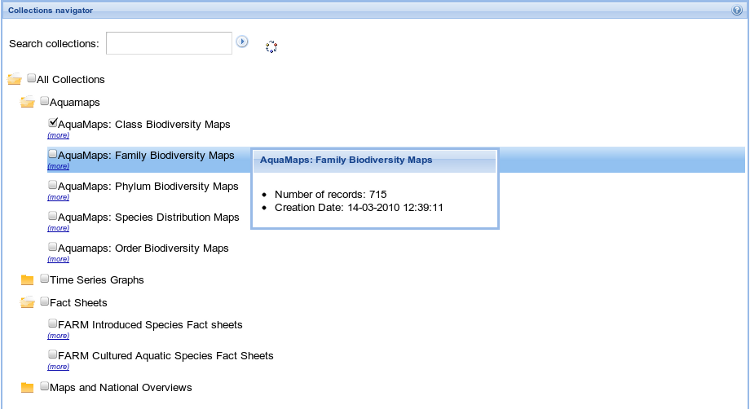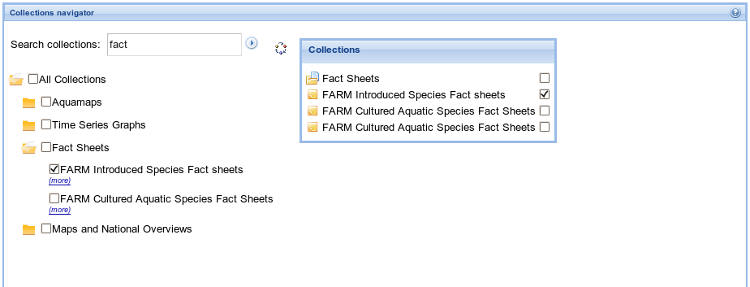Difference between revisions of "Search"
(→Select Collections) |
|||
| Line 10: | Line 10: | ||
A full description for each collection is available, if you click on ''(more)'' link. A pop up window appears containing a description of the corresponding collection as you can see in the image above. | A full description for each collection is available, if you click on ''(more)'' link. A pop up window appears containing a description of the corresponding collection as you can see in the image above. | ||
For each collection you can see its name, description (if it exists), number of records and the creation date.<br> | For each collection you can see its name, description (if it exists), number of records and the creation date.<br> | ||
| + | |||
For your flexibility you can search through the available collections for a keyword that may be included in collections name and/or description. The following image displays this functionality. | For your flexibility you can search through the available collections for a keyword that may be included in collections name and/or description. The following image displays this functionality. | ||
[[Image:SearchColls.png]]<br><br> | [[Image:SearchColls.png]]<br><br> | ||
The collections that you have already selected, are also selected at the pop-up window with the search results. You can deselect the already selected collections or select new collections. By clicking on the results at the pop-up window this change will also be applied at the collections tree.<br><br> | The collections that you have already selected, are also selected at the pop-up window with the search results. You can deselect the already selected collections or select new collections. By clicking on the results at the pop-up window this change will also be applied at the collections tree.<br><br> | ||
Revision as of 12:51, 24 February 2011
Search is one of the most important functionalities in the gCube system. Depending on the collections you want search through you can perform different kinds of searches. The default option is to search for a term anywhere in the selected collections, or you can search for more specific criteria. There is also the option to browse the contents of a collection and their distinct values based on a specific criterion.
After performing a search you can refine its results by searching for more specific terms in the current results. In order to perform a search or a browse, you first have to select collections. For this purpose you have to use the Select Collections portlet.
Independently of the search type all results are displayed by the Results portlet.
Select Collections
By using this portlet, you can select the desired collections in order to browse or search them.
The collections are presented in a tree hierarchy. The first level of nodes represents a collection group and each group contains several collections. In the following image, f.i. Aquamaps is a collection group. On the left of each checkbox, there is either a close folder icon or an opened folder icon. If there is a closed folder icon, it means that there are other collections inside this group of collections. By click on it, you can see the underlying collections. On the other hand, if there is an opened folder icon, it means that the node is expaned and you already see the inner collections (like AquaMaps: Class Biodiversity Maps). So, if you click on it, you can hide them.
In order to select/deselect a collection, you have to click on its name or checkbox. Additionally, you can select a group of collections simply by selecting the group of collections they belong to. As you can see below, if you select the Aquamaps collection group, then all the collections that belong to this group are selected.

A full description for each collection is available, if you click on (more) link. A pop up window appears containing a description of the corresponding collection as you can see in the image above.
For each collection you can see its name, description (if it exists), number of records and the creation date.
For your flexibility you can search through the available collections for a keyword that may be included in collections name and/or description. The following image displays this functionality.

The collections that you have already selected, are also selected at the pop-up window with the search results. You can deselect the already selected collections or select new collections. By clicking on the results at the pop-up window this change will also be applied at the collections tree.